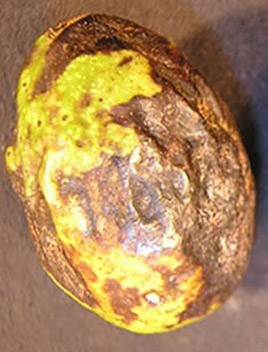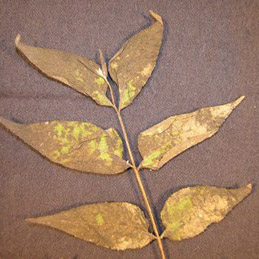Arkansas Plant Health Clinic Disease Notes
Contact
Plant Diagnostician
Phone: (479) 575-2727
Email: ssmith@uada.edu
Jason Pavel
Diagnostician
Phone: (479) 575-7257
Email: jpavel@uada.edu
University of Arkansas System Division of Agriculture
Cralley Warren Building
Room 16
2601 N. Young Ave.
Fayetteville, AR 72704
Walnut Bacterial Blight
Sherrie Smith and Jason Pavel - October 12, 2022
Plant Health Clinic Disease Note: Issue 34
Walnut

Walnut Bacterial Blight- Xanthomonas juglandis. Photo by Sherrie Smith, University of Arkansas Cooperative Extension
All walnuts are susceptible to Walnut Bacterial blight caused by Xanthomonas juglandis, with Persian walnuts being the most susceptible. New shoots, young leaves, and the husks of developing nuts can be infected from spring through fall during wet weather. The disease does the most damage if it occurs during flowering time. Younger trees are most affected. Older wood is not susceptible, and bacterial blight rarely kills the tree. However, entire nut crops can be lost when environmental conditions favor the disease during fruit set. The bacterium overwinters in buds that usually look healthy. The first symptoms are small, water-soaked spots, which enlarge, turn reddish-brown, and then black. Walnut Bacterial blight can be controlled by planting in soil with a pH above
6.0 and avoiding high rates of nitrogen and not over-watering. Damaged stems should be pruned out and destroyed. Prune only during dry weather. Copper sprays have had some effectiveness in reducing nut damage. The first copper spray should be applied at bud break, the second at female bloom, and the third at fruit set.
Take Aways:
- Plant in soil with pH above 0.
- Prune damage stems during dry.
- Apply copper fungicide at bud break, female bloom, and at fruit set.

Walnut Bacterial Blight- Xanthomonas juglandis. Photo by Sherrie Smith, University of Arkansas Cooperative Extension
This work is supported by the Crop Protection and Pest Management Program [grant no. 2017-70006- 27279/project accession no. 1013890] from the USDA National Institute of Food and Agriculture.